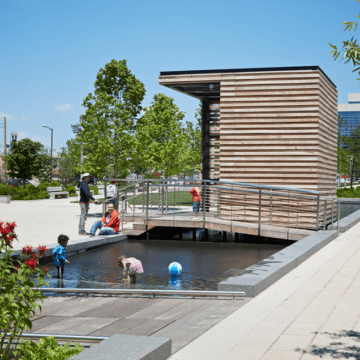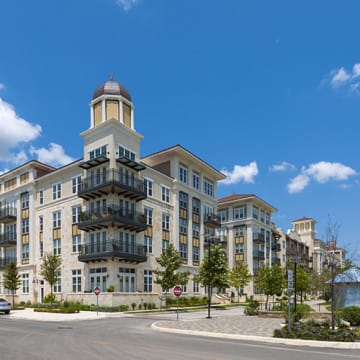Governors Island
After serving as a military base for over 200 years, the 172-acre (70 ha) Governors Island in the borough of Manhattan in New York City remained unoccupied for almost 10 years before reopening to visitors in 2005. Twenty-two acres (9 ha) are designated as a national park managed by the U.S. National Park Service. The remaining 150 acres (61 ha) are overseen by the Trust for Governors Island, including a 40-acre (16.2 ha) public park that exemplifies innovative design and space slated for future commercial development. Responding to past extreme weather events like Hurricane Sandy in 2012 and anticipating future ones, climate resilience and sustainability are fundamental to the park. Now, after over a decade of development and improvement, including the park’s construction, Governors Island is a beloved car-free and year-round destination serving New Yorkers and visitors from around the United States and the world.
Context
Located in New York Harbor between the boroughs of Manhattan and Brooklyn, Governors Island had a military presence from the late 1700s until 1996, for the U.S. Army and the Coast Guard. In 2003, the island came under control of the city and state of New York. Redevelopment commenced in 2010 when design firm West 8 won an international competition and presented the resulting Governors Island Park and Public Space Master Plan. Construction on a 40-acre (16.2 ha) public park began in 2012 and the park opened in 2016.
With over 1 million annual visitors, Governors Island consists of the park—which includes lawns, playgrounds, sports fields, food vendors, and a series of earthwork hills (the Hills) that provide panoramic views of the harbor and surrounding skylines—and education, nonprofit, and commercial facilities. In partnership with local organizations, Governors Island is intended to engage, excite, and educate the public in every aspect of urban agriculture, green infrastructure, and sustainability.
New York City’s average sea levels have risen by more than one foot (0.3 m) over the past century, a number that is double the global average. This, coupled with the reality of intensifying storms and floods, made prioritizing resilience to floods and extreme weather events top of mind for the redevelopment team. From the outset, the team saw it vital to embed climate resilience goals into all design and planning considerations. Many features of the park’s design address the impacts of climate change, including raising the site out of the 100-year floodplain, implementing a sustainable planting strategy, and mitigating wave action.
The park led to the creation of 40 acres (16.2 ha) of new public open space and the preservation of much more while making the area and its active and passive recreation choices accessible to millions of New Yorkers, many of whom lack access to high-quality park space. Combined with the park’s resilience measures, its focus on holistic sustainability is especially important for equitable open space access amid the climate crisis, given the proximity to low-lying areas in Manhattan and Brooklyn that will rely on Governors Island for park access and recreation.
Resilience and Sustainability Strategies
Resilient and sustainable design strategies are central to Governors Island, especially since it is poised to become a demonstration site to showcase new ways of developing and implementing climate resilience measures.
While the Hills on the island’s southern portion are the most visible icon of its resilient design approach, all of the park’s new landscapes incorporate native or locally adapted species chosen for their tolerance to salt and increasing temperatures as well as root structures that can reduce erosion.
Just five months after work began at Governors Island, Hurricane Sandy hit the park in 2012, putting its design strategies to the test. Although still under construction, the park sustained almost no damage. The park’s climate resilience and sustainability strategies include the following:
- Addressing flooding and sea-level rise: To protect the island from sea-level rise, the site was raised based on flood data projections for 2100. On the island’s western side, the existing seawall was replaced with a riprap revetment to provide stronger protection from wave action by dissipating the energy of waves. The white seat edges/park benches found throughout the park offer a dual purpose for visitors to relax and protect the Hills against wave action during storm surges.
- Stormwater management: The original site had over 19 acres (7.7 ha) of impermeable paved surfaces, creating excess runoff into the New York Harbor and hindering effective stormwater management. Addressing this, the park’s redesign team replaced those impermeable surfaces with plantings, lawn, and permeable paving to improve the island’s stormwater absorption capability.
- Mitigating extreme heat and the urban heat island effect: The New York City Department of Health estimates that, on average, 370 people suffer heat-related deaths per year in the city. Responding to this alarming figure, the park seeks to boost nature-based solutions to mitigate heat in a city well known as a concrete jungle. With the removal of impervious asphalt and prioritizing green infrastructure, the park’s native and locally adapted shrubs, trees, and plantings help reduce the urban heat island effect and mitigate extreme heat.
- Enhancing biodiversity: The park’s raised landscape lifts new trees and shrubs out of the flood zone, vital for the long-term survival of plants in floods. New plants at the park include 1,500 new trees at Hammock Grove and 860 new trees and 41,000 shrubs at the Hills. The park’s plantings and placements were carefully thought out to ensure their long-term viability. For example, grasses able to withstand brackish water were placed on lower-lying areas of the park while other plantings were chosen based on their tolerance to salt and future higher temperatures.
- Supporting urban agriculture and access to fresh foods: Governors Island hosts the GrowNYC Teaching Garden, a one-acre (0.4 ha) urban farm that aims to engage and educate visitors in all aspects of urban farming. The farm’s yields of vegetables, fruits, and herbs are donated to a food pantry that distributes fresh foods in Brownsville and East New York. With the garden open to the public in the spring and summer months, residents and visitors can cultivate their sense of environmental stewardship by expanding their knowledge on urban farming and the benefits of green infrastructure in an experiential way. During COVID-19, the garden pivoted from initial plans to focus on producing hundreds of pounds of fresh produce each week to neighborhood groups giving out food to residents in need.
- Community engagement and equitable park access: Between 2008 and 2010, the broader New York City community was engaged through surveys, exhibits, tours, presentations, and meetings to help envision the redevelopment of the island. To this day, the Trust for Governors Island continues community engagement as it plans for future phases of development and transformation. To ensure that the park is accessible to all, Governors Island has partnered with various agencies to offer free ferry rides to many visitors, including residents of New York City Housing Authority housing, seniors, children, current and former military servicemembers, and anyone with an IDNYC (a municipal identification card for New York City residents). The island’s enhanced accessibility efforts have proved valuable. In 2020, 40 percent of all visitors accessed the island at no cost, and overall, 99 percent of all New York City zip codes are represented in annual visitors to the island. The creation and preservation of high-quality open space for recreation, leisure, social gatherings, public events, and educational purposes continue to help draw an estimated 1 million visitors each year.
Value Proposition
Added amenity. While the island’s northern, elevated side long housed a military base and a coast guard, the southern side was largely neglected after being created by dumping landfill material from the Lexington Avenue subway line in 1905. Today, the completed Hills is a series of raised landscapes providing a series of defenses against future floods and rising sea levels without the use of seawalls. Visitors can enjoy the island’s entire 2.2-mile (3.5 km) promenade with the opening of the Hills and the popular Picnic Point. Prior, the southern portions of the promenade and Picnic Point had been closed since 2012. These new amenities, designed with coastal and flood resilience in mind, offer new opportunities for recreation and play.
Increased developable land. Anticipating future real estate opportunities and the value of mixed-use development, the island designated 33 acres (13.3 ha) on its southern side for future real estate. The island’s Historic District also hosts over 40 existing buildings available for reuse and leasing. To bring Governors Island’s commitment to sustainable and resilient design to life, plans are underway to establish the Center for Climate Solutions. The center will act as a hub that brings together interdisciplinary research focused on developing, testing, and scaling new tools for climate solutions with meaningful public engagement through educational and cultural experiences. The forward-thinking approach to resilience strategies coupled with this new center ensures that the park and the island not only will survive many future climate threats, but also will help create even better climate solutions for an ever-evolving crisis.
Lessons Learned
- Co-benefits for people and the planet: Governors Island demonstrates how resilient design strategies can create a host of co-benefits for people and the planet. Features like the wave-mitigating park benches and the raised Hills serve both human and climate adaptation needs—for rest and recreation, and protection against sea-level rise and extreme weather events, respectively. These design features highlight the interconnectedness of human experiences in parks and the preservation of open space to help future-proof natural hazards.
- Ensuring equitable access: A successful park fosters inclusivity and prioritizes access for low-income communities of color that are unevenly affected by a lack of green space access. Governors Island addresses an important disparity in park and green space access by offering free admission, free ferry rides from Manhattan to the island, and free public programming to engage the community at large.
- Persistent care and programming: Beyond Governors Island staff members and volunteers who provide ongoing stewardship, the park’s robust, year-round programming draws visitors to engage with the space in hands-on ways. The park serves as a venue for a variety of local organizations and offers events that provide environmental education and an appreciation for arts and culture. A small sampling of community events includes ice carving, jazz shows, wildlife walking tours, pop-up markets, and nature painting.


